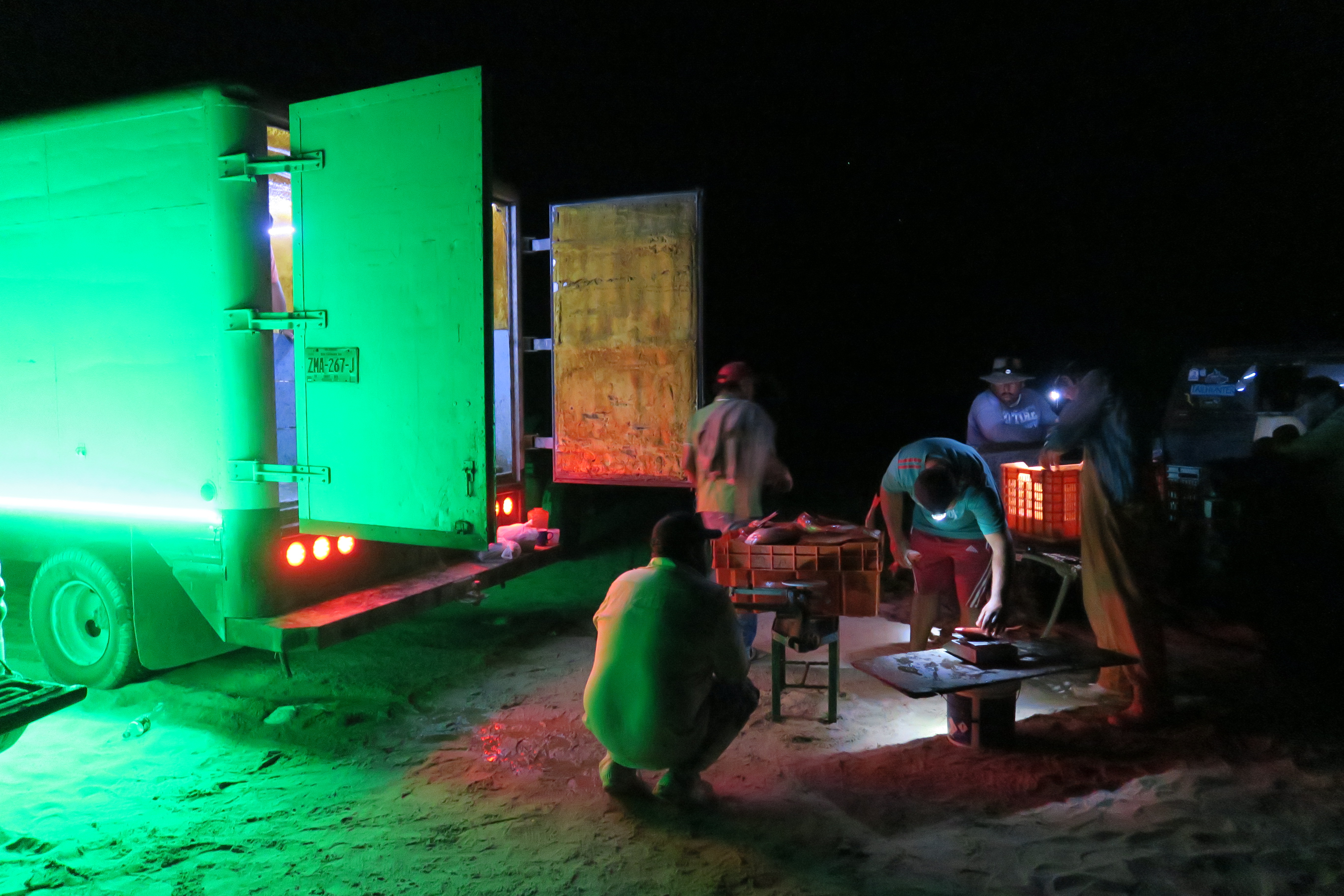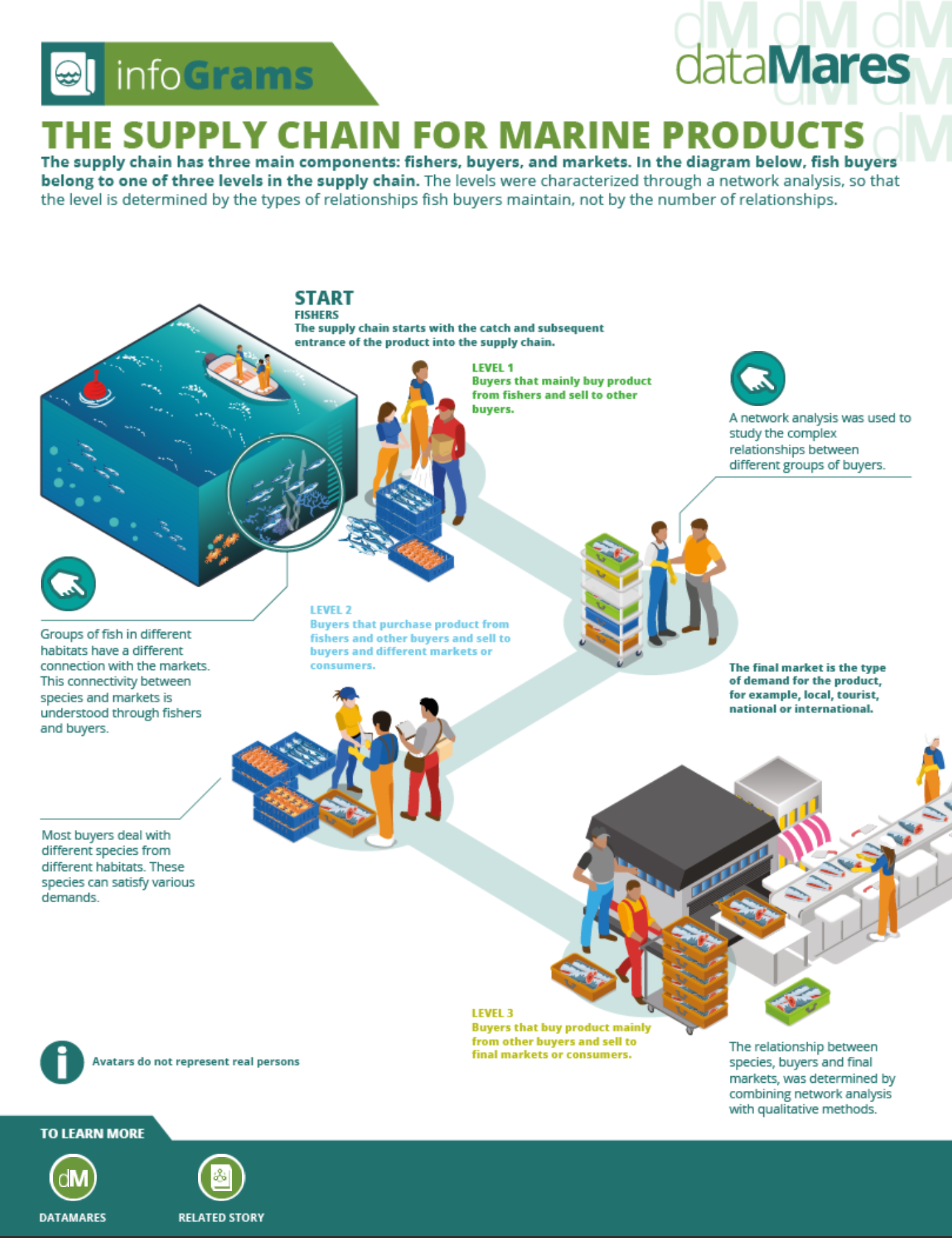Trading fish in Baja California Sur, Mexico.

How are finfish resources in the Gulf of California distributed to seafood markets? Who is involved in connecting fish from the Sea of Cortez to people’s plates in different parts of the world? This study looks into fish buyers in Baja California Sur, also called traders, as connectors between fishers and different seafood demands.
Understanding the influence of traders is important to better understand how these key actors could contribute or impede social-ecological sustainability (1, 2). For us, sustainability refers to meeting present and future human needs while safeguarding ecosystems, acknowledging that social and ecological systems are intertwined (3). This implies guaranteeing the sustainable exploitation of fisheries resources. The case of Mexico is especially interesting because the trading system overlaps with the management and governance system: since 1992, traders can own fishing permits.

We studied the trader’s system using a network approach, which represents traders as nodes connected to one another by links. In this case, links represent buying and/or selling relationships between traders that occur with a given frequency -e.g. weekly, monthly or during a specific season. This links do not represent discrete economic transactions, but the “stable” exchange of finfish between traders. Representing traders in a network allows us to observe the pattern of relations amongst traders and understand how these relationships might constrain or enable trading activity. This can help generate hypothesis on how the structure of traders could influence social and ecological sustainability, but how exactly this influence takes place is beyond the scope of this specific study.
Main findings
Traders in Baja California Sur are highly connected through a complex network of relationships, creating both horizontal interactions with similar traders, and vertical interactions with traders up or down the supply chain. High connectivity (i.e. lots of connections with other traders) could, for example, potentially enable them to better deal with the uncertainty inherent to fish supply and demand and sustain a more stable provision of fish. Moreover, most traders target diverse groups of species. These species have diverse habitats and satisfy different types of market demand. The diversity in the resources targeted could also help traders adapt to changes in the environment that potentially impact species availability and changes in market demand. Whether the traders will utilize these adaptive abilities in favor of more sustainable practices will likely vary from case to case.
We identified numerous differences amongst traders. For example, some traders establish relationships with fishers providing different types of assistance (e.g. loans, gas, ice, bait provision) in exchange for catch of a fisher; whereas other traders mainly trade in the city and do not establish such relationships. We also observe that some traders only sell to specific markets —such as exporting to international markets or satisfying the tourist demand in the region— whereas other traders sell to all types of market demands or only sell to other traders. Overall, some traders can be more influential than others and might have more opportunities to influence the local fish trade. Could some of these trader types have a high capacity to impede or promote overexploitation of fish resources?
Future research is needed to understand the strategies and incentives of diverse traders and how these result in different sustainability objectives, such as sustainable exploitation of fish populations and human well-being. Research that further investigates the diversity of traders embedded in complex networks of relationships can open the door to identifying innovative pathways to achieve sustainability in coupled social and ecological systems.
Click here to see the infogram.
The research and findings mentioned here result from the paper:González-Mon, B., Ö. Bodin, B. Crona, M. Nenadovic, and X. Basurto. 2019. Small-scale fish buyers’ trade networks reveal diverse actor types and differential adaptive capacities. Ecological Economics164.
The project is part of an international group of interdisciplinary sustainability scholars and practitioners focused on Mexico’s small-scale fisheries called MAREA, committed to understanding the connections among people and nature. More about MAREA here.
Authors:
Blanca González García-Mon*, Örjan Bodin*, Xavier Basurto‡, Mateja Nenadovic‡, Emilie Lindkvist*, Amy Hudson Weaver†
Contact Information:
DOI:
10.13022/M3Q92R
Affiliations:
*Stockholm Resilience Center, ‡Duke University, † Niparajá
Acknowledgements:
Thanks to all those who have participated in this research, especially to buyers and fishermen for sharing your day-to-day and knowledge. The project received funding from the European Research Council (ERC) under the European Union’s Horizon 2020 research and innovation programme (grant agreement No 682472 — MUSES). The research has been enabled by “La Caixa” Banking Foundation with the international grant for postgraduate studies awarded to Blanca González García-Mon.
How to cite this story:
Blanca González García-Mon, Örjan Bodin, Xavier Basurto, Mateja Nenadovic, Emilie Lindkvist, Amy Hudson Weaver (2018): Trading fish in Baja California Sur, Mexico. dataMares. InteractiveResource. https://doi.org/10.13022/M3Q92R
References
- Crona, B., Nyström, M., Folke, C., & Jiddawi, N. (2010). Middlemen, a critical social-ecological link in coastal communities of Kenya and Zanzibar. Marine Policy, 34(4), 761-771.
- Basurto, X., Bennett, A., Weaver, A. H., Rodriguez-Van Dyck, S., & Aceves-Bueno, J. S. (2013). Cooperative and noncooperative strategies for small-scale fisheries' self-governance in the globalization era: implications for conservation. Ecology and Society.
- Folke, C., Biggs, R., Norström, A. V., Reyers, B., & Rockström, J. (2016). Social-ecological resilience and biosphere-based sustainability science. Ecology and Society, 21(3).

